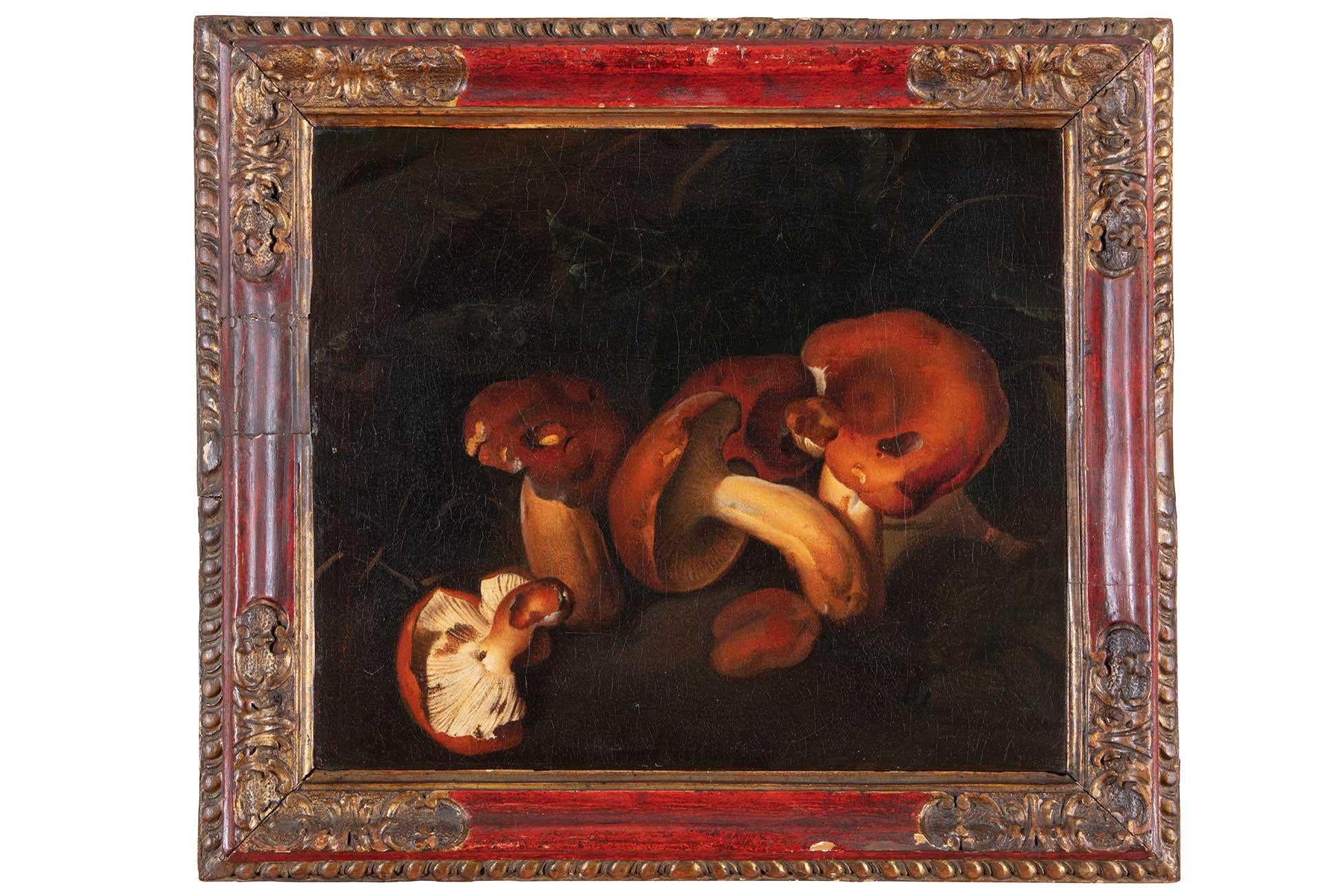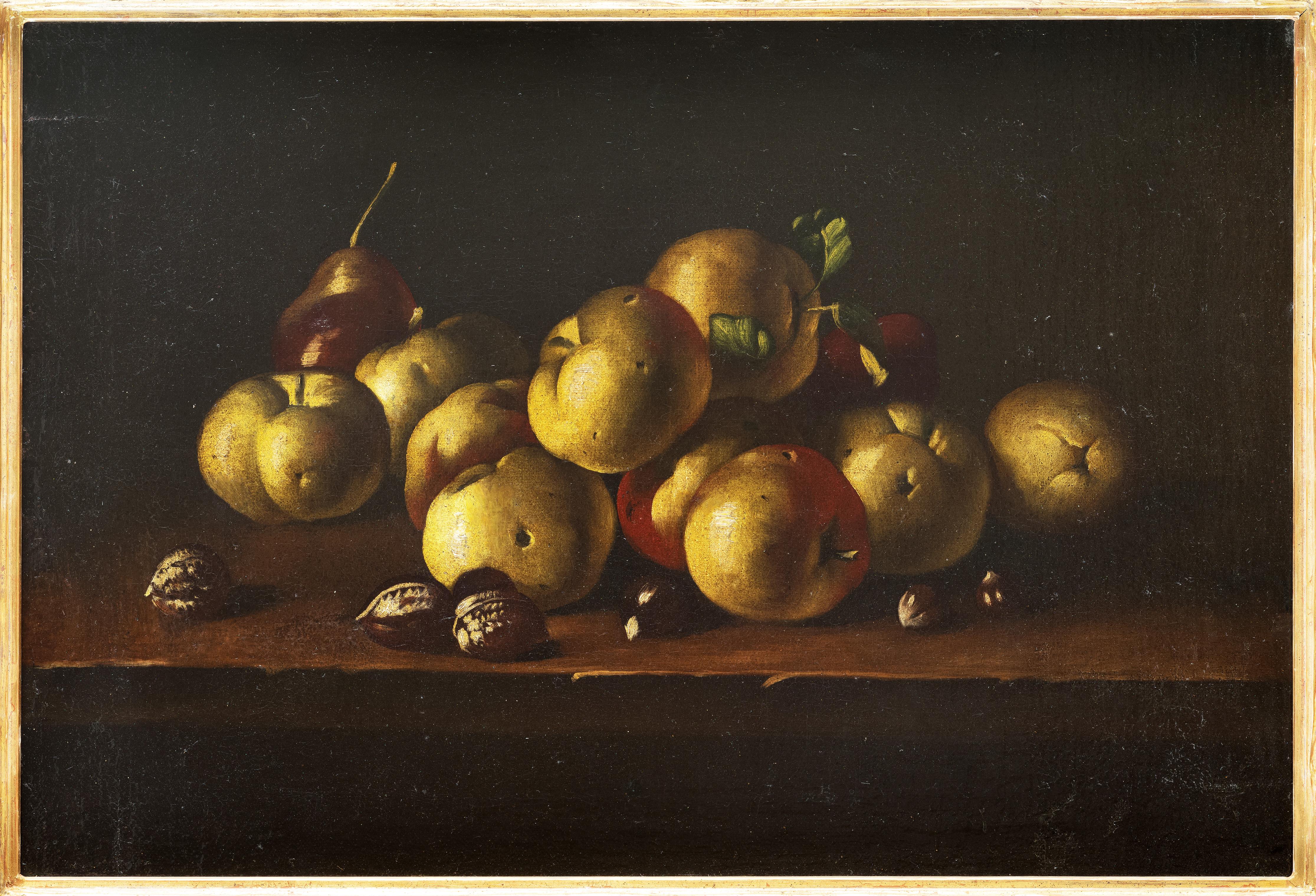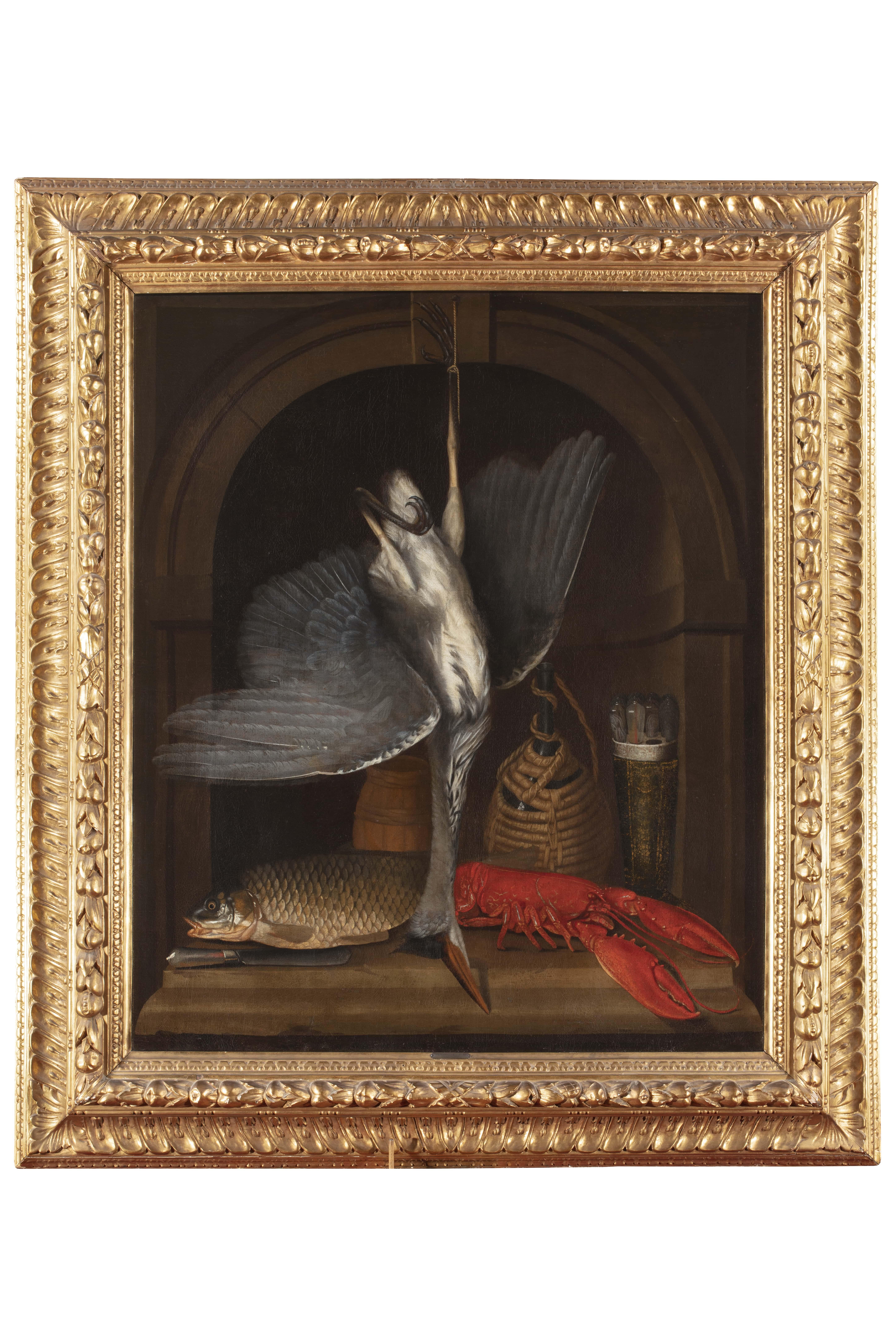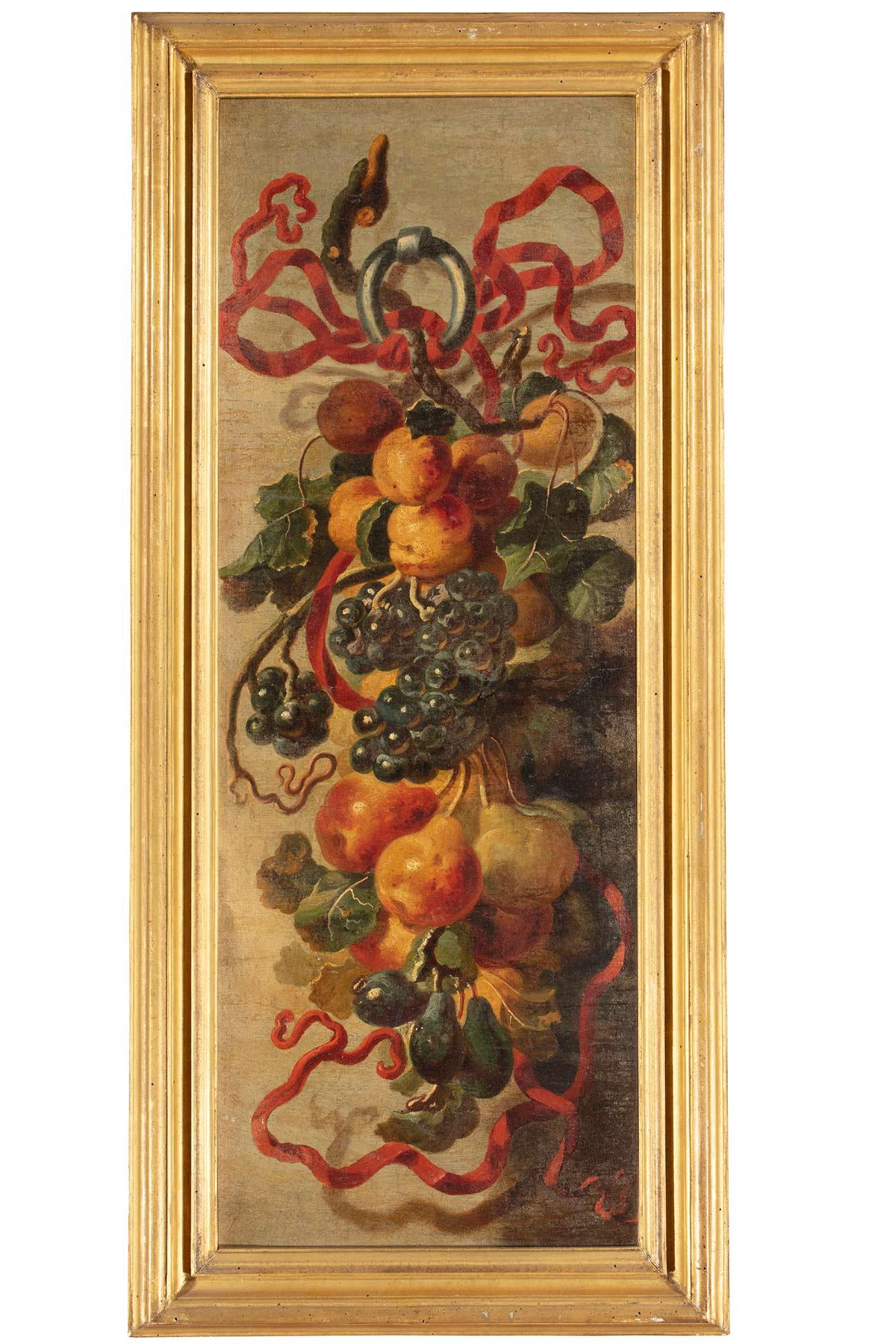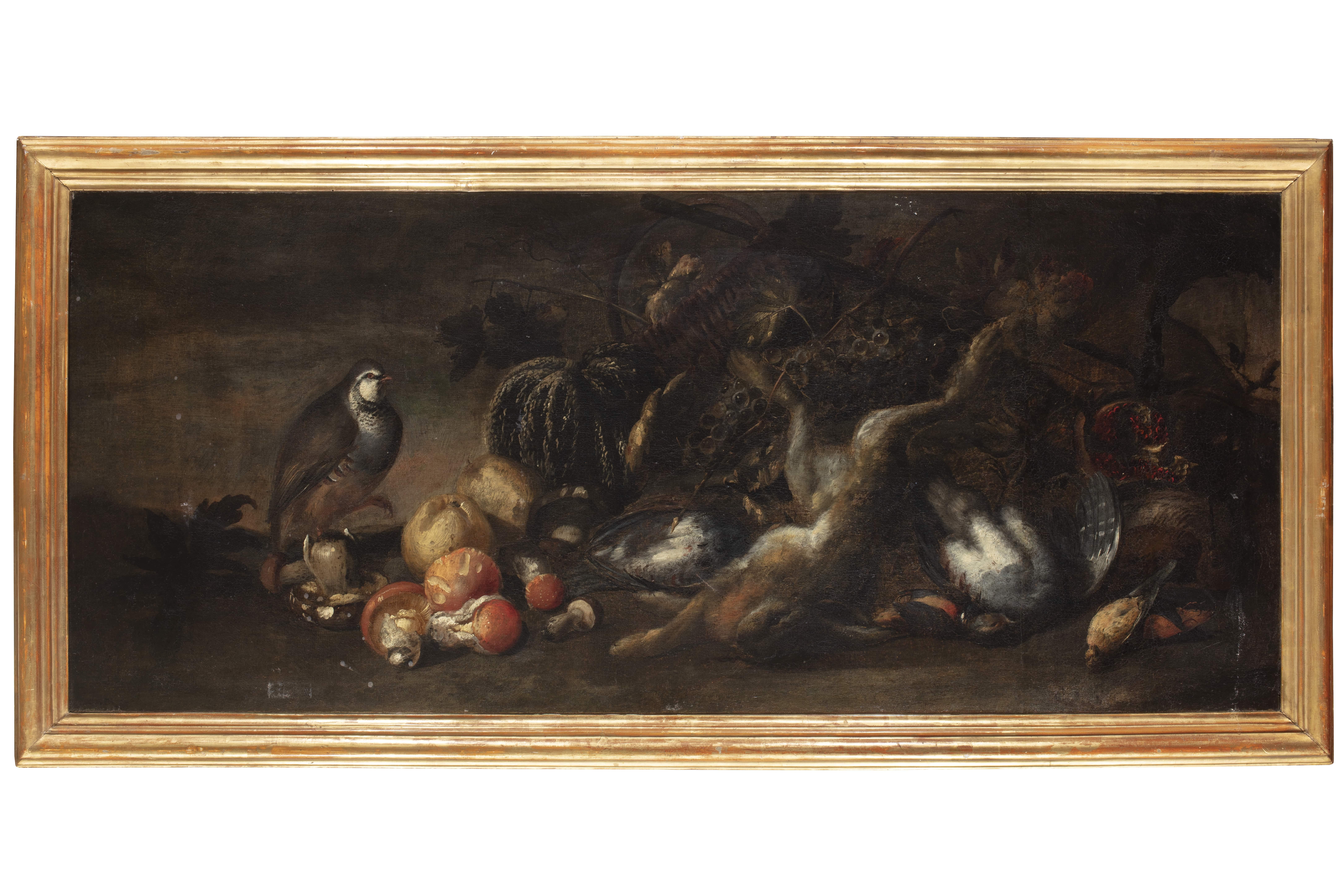Items Similar to Flower Garland by Giovanni Stanchi, the most Flemish Italian flower painter
Want more images or videos?
Request additional images or videos from the seller
1 of 11
Giovanni StanchiFlower Garland by Giovanni Stanchi, the most Flemish Italian flower painter1626 - 1640
1626 - 1640
About the Item
This painting is reproduced in the reference book on Roman still life "Pittori di nature morta a Roma - artisti italiani 1630 -1750" by Gianluca and Ulisse Bocchi - Arti Grafiche Castello 2005 (page 250 figure FS5), where it is mentioned as one of the few paintings that can be given with certainty to Giovanni Stanchi.
This highly decorative flower garland reveals a very strong Flemish influence, enabling us to attribute it with certainty to Giovanni Stanchi, the eldest of a sibling group of painters active in the production of still lifes in 17th century Rome. Probably painted before 1640, our garland conceals a mystical message beneath its decorative opulence, which we're about to reveal ...
1. Giovanni, Niccolò and Angelo Stanchi, a brotherhood of still-life painters in 17th-century Baroque Rome
The three Stanchi brothers, Giovanni (1608 - after 1675), Niccolò (ca. 1623 - 1690) and Angelo (1626 - after 1675) lived and worked together (like the Le Nain brothers), making identification of the different hands perilous.
Giovanni Stanchi's name is first mentioned in 1634, in the register of the painters' guild of the "Accademia di San Luca". Paid membership of the painters' guild provided not only a social network, but also commissions from important Roman families. In 1638, Giovanni Stanchi painted a picture for the Barberini family depicting their coat of arms surrounded by flowers. In 1660, he was commissioned by Cardinal Flavio Chigi to decorate a gallery with still lifes of flowers and fruit. The Chigis remained his principal patrons until after 1673. Thereafter, he received commissions from almost every important family in Rome. An invoice dated 1670 identifies Giovanni Stanchi and Mario Nuzzi as the painters responsible for the still lifes that decorated the famous mirrors in Palazzo Colonna. In 1675, Giovanni Stanchi's name appears for the last time in connection with a project in which he was engaged, together with Andries Bosman and the figure painter Ciro Ferri, to decorate the mirrors of the Palazzo Borghese on Campo Marzio.
Although all three brothers were active as painters, the records of their commissions always refer to Giovanni, since, as eldest brother, he was responsible for invoices and contracts. Only in a few cases is the name of one of the younger brothers mentioned. Only paintings with a strong Flemish influence dating from the first four decades of the 17th century, such as this one, can be attributed with certainty to Giovanni, as he was the only painter in the family at the time.
2. History of a genre: the flower garland
Jan Brueghel the Elder (Brussels 1568 - Antwerp 1625) is credited with inventing the flower garland theme during his stay in Rome in 1592. Such garlands were originally used to surround a religious subject, often a Marian one. This religious scene could sometimes be painted by another artist, as in the painting acquired in 1608 by Cardinal Borromeo, featuring a Madonna (painted by Henry van Balen), surrounded by a garland painted by Jan Brueghel.
This theme was taken up and developed in Rome from 1625 onwards by Daniel Seghers, before the young Giovanni Stanchi made it his own, reinforcing its symbolic dimension (to which we shall return) and moving away from the naturalistic approach of Jan Brueghel to develop a certain idealization of each flower, closer to the style of Mario Nuzzi (Rome 1603 - 1673). Giovanni Stanchi's garlands, of which he was the best Italian interpreter in the 17th century, also reveal him to be one of the most faithful to the Flemish tradition.
The book by Gianluca and Ulisse Bocchi lists nine still lifes very similar to ours, all executed on a black background (including the one reproduced as the last photo in the gallery, which belongs to the Pinacoteca Nazionale in Bologna). Because of their proximity to Flemish works, they can be attributed with certainty to Giovanni Stanchi. Four of them belong to private collections, while the others are all in public institutions (Anhaltische Gemäldegalerie, Dessau; Galeria del Palazzo Bianco, Genoa; Musée des Beaux-Arts, Bordeaux; Pinacoteca Nazionale, Bologna; Palazzo Chigi-Saraceni, Siena).
Like those in Flemish still lifes, the flowers depicted by Giovanni Stanchi bloom at different times of the year, ruling out any representation of a real bouquet. Alongside the more traditional flowers of our gardens (roses, tulips, hyacinths, daffodils, irises), it is also interesting to note the frequent inclusion of more exotic flowers such as jasmine and blue bindweed (ipomoea indica), which had been recently introduced to Europe from Mexico.
Each flower painted by Giovanni Stanchi seems to have its own individuality, a trait characteristic of Flemish painting, of which Stanchi was the best interpreter in Italy. One could say that Stanchi does not depict garlands of flowers, but flowers in a garland, each with its own identity and specificity, making it unique and different from the others. Captured in a low-angled light that seems to have captured them for eternity, they are drawn with clear, precise lines. As if they had been freshly cut, they emerge from the darkness in geometric figures that reinforce the tactile quality of their representation.
One of Giovanni Stanchi's distinctive features is to have substituted the central religious representation traditionally associated with Flemish flower garlands with a flight of goldfinches and butterflies.
3. Symbolic interpretation
In the 17th century, the contemplation of nature, through the variety of animals and plants, was considered a metaphysical activity, generating an appetite for eternal life. In this context, each representation of nature can conceal a symbolic dimension, presenting a complex, cryptic message that we propose to shed light on.
At the beginning, the garland of flowers is a symbol of the hortus conclusus, the walled garden evoked in the Song of Songs, and later interpreted as a symbolic image of Mary's virginity, but also as the place where the spiritual life can develop, protected from the world and its temptations. The garland thus becomes the image of the garden of the soul, a perfect imaginary space in which mystical emotions can develop. The emotion created by the beauty and fragility of flowers (which, it should be remembered, cannot coexist simultaneously in nature) tangibly affirms the equal dignity of the natural and the artificial. The apparent disorder of the flowers becomes geometrically ordered, and chromatically structured by the painter, who gives us the illusion that this garland is in suspension, freed from all constraints of gravity.
Since the Greek antiquity, the butterfly has been the symbol of the soul - which is why young Psyche's back is adorned with butterfly wings - but also of the access to the divine. In the Christian world, the butterfly became the symbol of the eternal life of the soul that leaves the body after death.
The goldfinch (often depicted in the hands of the Infant Jesus in Madonna and Child paintings, as in the Uffizi painting by Raphael) is also a representation of the soul, but in addition an evocation of Christ's crucifixion. Goldfinches are known for their taste for thistles, whose thorns evoke the crown worn by Christ during the Passion. According to some legend, a goldfinch stained its feathers with Christ's blood while removing a thorn from his forehead, a stain that has since been perpetuated among all goldfinches!
All these elements confirm that Stanchi, beyond the undeniable decorative strength of his paintings, is indeed inviting us to a philosophical meditation whose cryptic meaning was immediately comprehensible to the cultivated public of Roman dignitaries for whom his canvases were intended.
4. Framing and painting presentation
Our painting is framed in a modern Flemish-style frame that echoes Giovanni Stanchi's Flemish inspiration. A particularity of this painting is that it can be presented both vertically and horizontally.
- Creator:Giovanni Stanchi (1608 - 1675, Italian)
- Creation Year:1626 - 1640
- Dimensions:Height: 45.25 in (114.94 cm)Width: 59.25 in (150.5 cm)
- Medium:
- Movement & Style:
- Period:
- Condition:87 x 135 cm (34 ¼'' x 53 1/8 '') - Framed: 115 x 150.5 cm (45 1/4 '' x 59 ¼'').
- Gallery Location:PARIS, FR
- Reference Number:1stDibs: LU1568214078472
About the Seller
5.0
Vetted Seller
These experienced sellers undergo a comprehensive evaluation by our team of in-house experts.
Established in 2020
1stDibs seller since 2021
8 sales on 1stDibs
Typical response time: 2 hours
- ShippingRetrieving quote...Ships From: PARIS, France
- Return PolicyA return for this item may be initiated within 3 days of delivery.
More From This SellerView All
- Baroque silver Vase with Flowers with a Fruit Tray and a Clock by A. ZuccatiLocated in PARIS, FRThis unpublished composition is a recent addition to Adeodato Zuccati’s catalog. The study of this painting by Gianluca Bocchi, an Italian art historian specializing in Italian still lives, is available upon request. This composition is typical of the productions of Adeodato Zuccati, an Emilian painter...Category
Late 17th Century Old Masters Still-life Paintings
MaterialsCanvas, Oil
- Ten dog studies and a study of a stole, a panel attributed to Jan WeenixBy Jan WeenixLocated in PARIS, FRThis painting is typical of the art of Jan Weenix, one of the best still life and hunting painters of the Dutch Golden Age. In a cleverly disordered manner, he depicts ten studies of dogs (mainly spaniels and greyhounds) and the sumptuous study of a stole. These studies were probably intended to be used as a source of inspiration and adapted in the painter's compositions, as we will see in a close examination of some of his paintings. 1. Jan Weenix, a prolific still life painter Jan Weenix was born into a family of artists: his father Jan Baptist Weenix (1621 - 1659) was also a landscape and still life painter and his mother Josyntgen d'Hondecoeter was the daughter of the animal painter Gillis d'Hondecoeter (1575 - 1638). His father trained him together with his cousin Melchior d'Hondecoeter (1636 - 1695). In 1664 Jan Weenix became a member of the St. Luke's Guild in Utrecht, to which he belonged until 1668. In 1679 he married Pieternella Backer with whom he had 13 children. His compositions, often related to hunting (still lifes, portraits of hunters) were very successful, ensuring him a certain financial ease. Jan Weenix also painted large-scale decorations: while staying in Düsseldorf with the Prince-Elector of the Palatinate between 1702 and 1712, he executed twelve gigantic compositions combining landscapes, hunting scenes and still life for the Bensberg hunting lodge. 2. Description of the artwork The painting displays a great apparent disorder that hides a rigorous organisation in four quarters. It presents ten studies of hunting dogs and one study of a stole. The studies of the stole and of two of the dogs (the greyhound in the lower right and the spaniel in the upper right quarter) are quite elaborate, whereas those of the other dogs are sketchier. As an example, the dog in the upper right corner is only partially painted. The dogs' coats, of different colours - brown, sandy, grey or black - stand out against the warm brown background and are illuminated by the shine of their white hair. This white colour, probably executed with ceruse white, illuminates the study of a stole which stands out in the lower left-hand corner while the red colour of its lining warms up the composition. The purpose of this stole is enigmatic: we think it is probably a neckband, but it could also be the back of the turban of an oriental character. To the right of this stole is the outline of a long animal leg, perhaps a horse leg. Similar studies are rare in the work of Jan Weenix, but the Rijksmuseum recently acquired the study of a seated monkey. This study, executed in the same brown chromatic range, is much more accomplished. It has been reused with minimal change in many compositions. It is likely that Jan Weenix had less frequently a monkey at his disposal, and that he therefore depicted it in great details, whereas he could probably easily find dogs as models. Note the characteristic white dot in the corner of each pupil that brings them to life! 3. Related artworks We have tried to relate the various dogs in this study to the countless dogs that appear in the paintings of Jan Weenix, as listed in the catalogue 'Father and Son - Weenix' compiled by Anke van Wagenberg- Ter Hoeven in 2018. A first example is the painting entitled "The Prodigal Son on the Steps of a Palace" (catalogue number 7 - 8th photo in the gallery). In the lower left-hand corner of the composition, a spaniel is barking at a peacock perched on a stone. This spaniel, which is depicted in a similar manner in the "Portrait of a Young Man with a Falcon" in the Bremen Kunsthalle (catalogue number 76), is reminiscent of the spaniel in the upper left-hand quarter of our study (although the latter is slenderer and the direction of its head differs). We also find, in a slightly different pose, the seated greyhound that is at the top of our painting in the composition representing "A Swan, a Stag, a Hare and Birds presented by two hunting Valets" (catalogue number 130 - last photo in the gallery). The sketch of this greyhound in our study is unfinished: the painter only painted the grey undercoat and the white parts of the coat, without completing the sandy coat which appears in the final painting. We can see from these various examples that our study was probably more a repertoire of forms than a model for a specific composition. The painter probably used it for inspiration before adapting each dog study...Category
Late 17th Century Old Masters Animal Paintings
MaterialsOak, Oil
- Still Life with Herring, a panel by the workshop of Georg Flegel (1566 - 1638)Located in PARIS, FRFred G. Meier, art historian, confirmed with the following comment, after a photographic examination of the work, that it belongs to the studio of Georg Flegel...Category
1630s Old Masters Still-life Paintings
MaterialsOak, Oil
- Herminia and the Shepherds, a painting by Francesco de Mura (Napoli 1696 - 1782)By Francesco de MuraLocated in PARIS, FRIn this masterly painting, Francesco de Mura presents the meeting of Herminia and the shepherds, a famous episode taken from the seventh canto of Torquato Tasso's Jerusalem Delivered...Category
1760s Old Masters Figurative Paintings
MaterialsCanvas, Oil
- Two royal portraits (the Duc d'Angoulême and the Duc de Berry) by H.P. DanlouxLocated in PARIS, FRThese two royal portraits are a major historical testimony to the stay of the Comte d'Artois (the future Charles X) and his family in Edinburgh in 1796-1797. Given by the sitters to Lord Adam Gordon, the Governor of Edinburgh, and kept by family descent to this day, these two portraits provide us with a vivid and spontaneous image of the Duc d’Angoulême and his brother the Duc de Berry. Danloux, who had emigrated to London a few years before, demonstrate his full assimilation of the art of British portrait painters in the brilliant execution of these portraits. 1. Henri-Pierre Danloux, a portraitist in the revolutionary turmoil Born in Paris in 1753, Henri-Pierre Danloux was first a pupil of the painter Nicolas-Bernard Lépicié (1735 - 1784) and then, in 1773, of Joseph-Marie Vien (1716 - 1809), whom he followed to Rome when, at the end of 1775, Vien became Director of the Académie de France. In Rome he became friends with the painter Jacques-Louis David (1748 - 1825). Returning to France around 1782, he settled in Lyon for a few years before returning to Paris in 1785. One of his first portraits was commissioned by the Baroness d'Etigny, the widow of the former Intendant of the Provinces of Gascony, Bearn and Navarre Antoine Mégret d'Etigny (1719 – 1767). He then became close to his two sons, Mégret de Sérilly and Mégret d'Etigny, who in turn became his patrons. In 1787, this close relationship with the d'Etigny family was further strengthened by his marriage to Antoinette de Saint-Redan, a relative of Madame d'Etigny. After his marriage, he left for Rome and did not return to France until 1789. It was during the winter of 1790-1791 that he painted one of his masterpieces, the portrait of Baron de Besenval. Set in a twilight atmosphere, this portrait of an aristocrat who knows that his death is imminent symbolizes the disappearance of an erudite and refined society which would be swept away by the French Revolution. The Jacobin excesses led Danloux to emigrate to England in 1792; many members of his family-in-law who remained in France were guillotined on 10 May 1794. Danloux enjoyed great success as a portrait painter in England before returning to France in 1801. During his stay in England, Danloux was deeply under the influence of English portraitists: his colors became warmer (as shown by the portrait of the Duc d'Angoulême that we are presenting), and his execution broader. 2. Description of the two portraits and biographical details of the sitters The Duc d'Angoulême (1775-1844) was the eldest son of the Comte d'Artois, the younger brother of King Louis XVI (the future King Charles X), and his wife Marie-Thérèse of Savoie. He is shown here, in the freshness of his youth, wearing the uniform of colonel-general of the "Angoulême-Dragons" regiment. He is wearing the blue cordon of the Order of the Holy Spirit, which was awarded to him in 1787, and two decorations: the Cross of Saint-Louis and the Maltese Cross, as he was also Grand Prior of the Order of Malta. Born on 16 August 1775 in Versailles, Louis-Antoine d'Artois followed his parents into emigration on 16 July 1789. In 1792, he joined the émigrés’ army led by the Prince de Condé. After his stay in Edinburgh (which will be further discussed), he went to the court of the future King Louis XVIII, who was in exile at the time, and in 1799 married his first cousin Marie-Thérèse Charlotte of France, the daughter of Louis XVI and the sole survivor of the royal family. The couple had no descendants. He became Dauphin of France in 1824, upon the accession to the throne of his father but played only a minor political role, preferring his military position as Grand Admiral. Enlisted in Spain on the side of Ferdinand VII, he returned home crowned with glory after his victory at Trocadero in 1823. He reigned for a very short time at the abdication of Charles X in 1830, before relinquishing his rights in favor of his nephew Henri d'Artois, the Duc de Bordeaux. He then followed his father into exile and died on 3 June 1844 in Gorizia (now in Italy). His younger brother, the Duc de Berry, is shown in the uniform of the noble cavalry of the émigrés’ Army. He is wearing the blue cordon of the Order of the Holy Spirit, awarded to him in May 1789, and the Cross of Saint-Louis (partly hidden by his blue cordon). Born on 24 January 1778 in Versailles, Charles-Ferdinand d'Artois also followed his parents into emigration and joined the émigrés’ army in 1792. After his stay in Edinburgh, he remained in Great Britain, where he had an affair with Amy Brown...Category
1790s Old Masters Portrait Paintings
MaterialsCanvas, Oil, Wood Panel
- The Parade of Swiss Guards a painting on canvas by Gabriel de Saint-AubinLocated in PARIS, FRIn this painting, Gabriel de Saint-Aubin, the great chronicler of the reign of Louis XV, takes us to the annual parade of the Swiss Guards at the Plaine de...Category
1760s Old Masters Figurative Paintings
MaterialsCanvas, Oil
You May Also Like
- Still Life with Squash, Gourds, Stoneware, and a Basket with Fruit and CheeseLocated in New York, NYProvenance: Selma Herringman, New York, ca. 1955-2013; thence by descent to: Private Collection, New York, 2013-2020 This seventeenth century Spanish still-life of a laden table, known as a bodegón, stands out for its dramatic lighting and for the detailed description of each object. The artist’s confident use of chiaroscuro enables the sliced-open squash in the left foreground to appear as if emerging out of the darkness and projecting towards the viewer. The light source emanates from the upper left, illuminating the array, and its strength is made apparent by the reflections on the pitcher, pot, and the fruit in the basket. Visible brush strokes accentuate the vegetables’ rough surfaces and delicate interiors. Although the painter of this striking work remains unknown, it is a characteristic example of the pioneering Spanish still-lifes of the baroque period, which brought inanimate objects alive on canvas. In our painting, the knife and the large yellow squash boldly protrude off the table. Balancing objects on the edge of a table was a clever way for still-life painters to emphasize the three-dimensionality of the objects depicted, as well a way to lend a sense of drama to an otherwise static image. The knife here teeters on the edge, appearing as if it might fall off the table and out of the painting at any moment. The shape and consistency of the squash at left is brilliantly conveyed through the light brush strokes that define the vegetable’s fleshy and feathery interior. The smaller gourds—gathered together in a pile—are shrouded partly in darkness and stand out for their rugged, bumpy exterior. The stoneware has a brassy glaze, and the earthy tones of the vessels are carefully modulated by their interaction with the light and shadow that falls across them. The artist has cleverly arranged the still-life in a V-shaped composition, with a triangular slice of cheese standing upright, serving as its pinnacle. Independent still-lifes only became an important pictorial genre in the first years of the seventeenth century. In Italy, and particularly through the revolutionary works of Caravaggio, painted objects became carriers of meaning, and their depiction and arrangement the province of serious artistic scrutiny. Caravaggio famously asserted that it was equally difficult to paint a still-life as it was to paint figures, and the elevation of this new art form would have profound consequences to the present day. In Spain Juan Sanchez Cotan...Category
17th Century Old Masters Still-life Paintings
MaterialsCanvas, Oil
- Still Life with Apples and Nuts, 17th Century, Old Master, Spanish PaintingLocated in Greven, DEJuan Sánchez Cotán (1560 - 1627) was one of the most important still life painters in Spain and beyond. He developed a certain type of still life with a ...Category
17th Century Old Masters Still-life Paintings
MaterialsCanvas, Oil
- 17th Century by Giovanni Paolo Castelli Still Life Oil on CanvasBy Giovanni Paolo Castelli detto SpadinoLocated in Milano, LombardiaGiovanni Paolo Castelli called Spadino (Rome 1659 - Rome 1730) Still life Oil on canvas, cm. 81x31 - with frame cm. 92x41 Shaped and gilded wo...Category
Late 17th Century Old Masters Still-life Paintings
MaterialsCanvas, Cotton Canvas, Oil
- 17th Century by Nicolas van Houbraken Still Life with Mushrooms Oil on CanvasLocated in Milano, LombardiaNicolas Van Houbraken (Messina, 1668 - Pisa, 1733) Still life with mushrooms Oil on canvas, cm. 26 x 32 - with frame cm. 38,5 x 33,5 Antique cassetta frame made of carved wood and ...Category
17th Century Old Masters Still-life Paintings
MaterialsCotton Canvas, Canvas, Oil
- Late 17th Century By Still-life Italian painter Still life Oil on CanvasLocated in Milano, Lombardia58 x 136 cm without frame, 71.5 x 150 cm with frame Antique shaped and gilded wooden box frame Publications: unpublished This beautiful painting shows a varied still life with var...Category
17th Century Old Masters Still-life Paintings
MaterialsCanvas, Oil
- 18th Century by Francesco Lavagna Pair of Flower Vases Oil on CanvasLocated in Milano, Lombardia98 x 36 cm each without frame - 112 x 50 cm with frame Antique gilded and shaped wooden box frames Expertise by Prof. Giancarlo Sestieri This marvellous pair of flower vases has b...Category
Early 18th Century Old Masters Figurative Paintings
MaterialsCanvas, Oil
